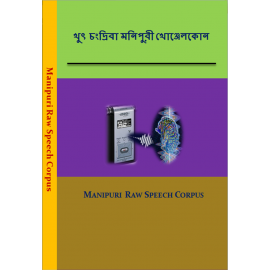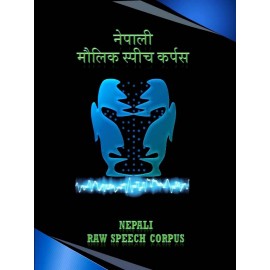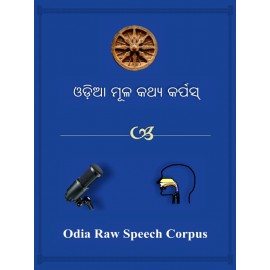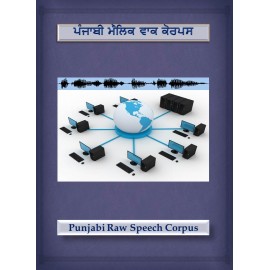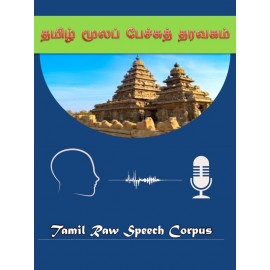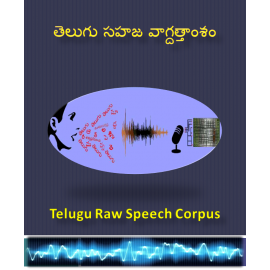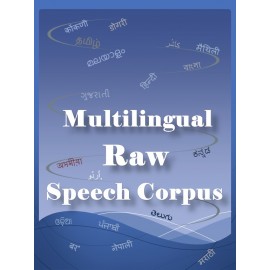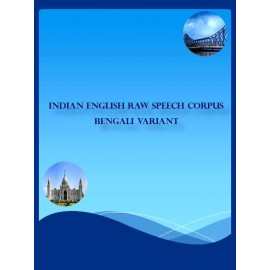Raw Corpus
Raw Corpus for Speech
Manipuri Raw Speech Corpus
156:28:32 hours | 100 GB | 620 Speakers | 66,231 Audio segments | 48 khz | 16 bit wav Manipuri is the Administrative Language of Manipur. The development of LDC-IL Speech Data for Manipuri lies in capturing all the distinctive characteristics of speeches shared by different regional dialects of Manipur. In order to do so, certain linguistic features identifying regional tones and intonations, phonemic distributions, various pronunciations reflected in both regional and non-regional vocabulary items such as person names and place names etc., have been well housed based on a standard parameter of the dataset. Out of the entire dataset, each specific subset to be read by the corresponding speaker is randomly generated for ‘a read speech corpus’. In this way, each random set is read by a speaker. Limited Full Sets are made read completely by assured selected speakers in each age group. The data is collected from three regional dialects, namely Imphal, Kakching, and Awang Sekmai respectively through fieldwork. The age group ranges selected for fieldwork are ‘16 to 20’, ‘21 to 50’, and ‘above 50 years’ respectively. Equal number of male and female data is collected from each age group. The available Speech Corpus details : Total Speakers620(310 Female and 310 Male) Domains Audio Segments Each Domain Duration Contemporary Text (News) 530 59:47:22 Creative Text 588 53:59:03 Sentence 10,979 10:01:41 Date Format 866 01:12:04 Command and Control Words 13,129 08:00:02 Person Name 8,789 07:14:04 Place Name 4,394 02:46:29 Most Frequent Word - Part 13,167 06:48:50 Most Frequent Word - Full Set 6,992 02:48:42 Phonetically Balanced 4,518 02:25:53 Form and Function - Word 2,279 01:23:50 A detailed explanation of the Manipuri Speech corpus will be available in the Manipuri Raw Speech Corpus Documentation.For any research based citations, please use the following citations:Ramamoorthy, L., Narayan Choudhary, Amom Nandaraj Meetei, Yumnam Premila Chanu & Longjam Anand Singh. 2019. Manipuri Raw Speech Corpus. Central Institute of Indian Languages, Mysore.Choudhary, Narayan, Rajesha N., Manasa G. & L. Ramamoorthy. 2019. “LDC-IL Raw Speech Corpora: An Overview” in Linguistic Resources for AI/NLP in Indian Languages. Central Institute of Indian Languages, Mysore. pp. 160-174...
Marathi Raw Speech Corpus
89:17:25 Hours | 58 GB speech data | 307 Speakers | 58544 Audio segments | 48 kHz | 16 bit wav.The Marathi language is an Indo-Aryan language. The Marathi language is prevalent in the 9th century. Standard Marathi (Puneri) is the official language of the State of Maharashtra. Standard Marathi is based on dialects used by academics and the print media. It is believed that the language of the Marathi language is influenced by Sanskrit. Marathi is written in the Devanagari script. The phoneme inventory of Marathi is similar to that of many other Indo-Aryan languages. The LDC-IL speech data is collected from the regions of Marathwada, Puneri, Vidharbh, and Goa from both the genders and different age groups. Each speaker recorded these datasets which are randomly selected from a master dataset. The available Speech Corpus details:Total Speakers 307 (156 Female and 151 Male) Domains Audio Segments Each Domain Duration Contemporary Text (News) 302 22:26:06 Creative Text 302 13:37:34 Sentence 7,555 6:49:58 Date Format 604 0:39:57 Command and Control Words 9,068 7:50:10 Person Name 6,058 7:44:56 Place Name 3,037 2:49:32 Most Frequent Word - Part 9,104 7:22:57 Most Frequent Word - Full Set 10,987 9:53:28 Phonetically Balanced 4,609 4:10:47 Form and Function - Word 6,918 5:52:00 A detailed explanation of the Marathi Speech Corpus will be available in the Marathi Speech Data Documentation.For any research-based citations, please use the following citations: Ramamoorthy, L., Narayan Choudhary, Gajanan R Apine & Apurva P Betkekar. 2019. Marathi Raw Speech Corpus. Central Institute of Indian Languages, Mysore.Choudhary, Narayan, Rajesha N., Manasa G. & L. Ramamoorthy. 2019. “LDC-IL Raw Speech Corpora: An Overview” in Linguistic Resources for AI/NLP in Indian Languages. Central Institute of Indian Languages, Mysore. pp. 160-174...
Nepali Raw Speech Corpus
87:14:44 Hours | 56.5GB | 350 Speakers | 48975 Audio Segments | 48 kHz | 16 bit wav.Nepali belongs to the Indo-Aryan language family. Nepali is the official language of Nepal and Indian State of West Bengal and Sikkim, and spoken in the states of Uttaranchal, Assam, Arunachal Pradesh, Manipur, Mizoram and Bihar, and as well as in other countries like Myanmar, Bhutan etc. It is written in Devanagari script. The LDC-IL Nepali speech data is collected from the regions of Darjeeling, Assam and Dehradun, from both the genders and different age group. The LDC-IL Nepali Speech data set consists of different types of datasets that are made up of word lists, sentences, running texts and date formats.The available Speech Corpus details:Total Speakers 350 (187 Female and 163 Male)) Domains Audio Segments Each Domain Duration Contemporary Text (News) 343 14:33:19 Creative Text 341 19:46:34 Sentence 8,583 13:45:34 Date Format 1,029 00:57:20 Command and Control Words 10,308 08:44:19 Person Name 6,878 09:15:04 Place Name 3,398 03:20:06 Most Frequent Word - Part 10,292 08:51:06 Most Frequent Word - Full Set 2,994 03:41:39 Phonetically Balanced 3,321 03:00:08 Form and Function - Word 1,488 01:19:35 A detailed explanation of the Nepali Speech Corpus will be available in the Nepali Speech Data Documentation. For any research-based citations, please use the following citations:Ramamoorthy, L., Narayan Choudhary, Samar Sinha, Jeena Rai, Umesh Chamling Rai & Rupesh Rai. 2019. Nepali Raw Speech Corpus. Central Institute of Indian Languages, Mysore.Choudhary, Narayan, Rajesha N., Manasa G. & L. Ramamoorthy. 2019. “LDC-IL Raw Speech Corpora: An Overview” in Linguistic Resources for AI/NLP in Indian Languages. Central Institute of Indian Languages, Mysore. pp. 160-174...
Odia Raw Speech Corpus
138:06:18 hours | 89 GB | 474 Speakers | 73,418 Audio segments | 48 kHz | 16 bit wav.Odia is an Indo-Aryan language; which is mainly spoken in the state of Odisha and also in some of the border states like West Bengal, Jharkhand, Chhatisgarh and Andhra Pradesh. It is designated with Classical Language Status by the Govt. of India. The LDC-IL Odia speech data is collected from the Central and Northern parts of Odisha from both the genders and different age groups. This data consists of different types of datasets that are made up of word lists, sentences include running texts and date formats.The available Speech Corpus details:Total Speakers 474 (239 Female and 235 Male)DomainsAudio SegmentsEach DomainDurationContemporary Text (News)44942:49:56Creative Text45019:43:50Sentence11,2488:22:57Date Format9001:27:49Command and Control Words13,49914:18:49Person Name8,9985:01:40Place Name4,49613:22:45Most Frequent Word - Part8,9949:40:04Most Frequent Word - Full Set10,98910:21:04Phonetically Balanced10,43810:05:10Form and Function - Word2,9572:52:14A detailed explanation of the Bengali Speech Corpus will be available in the Odia Raw Speech Data Documentation. For any research-based citations, please use the following citations: Ramamoorthy, L., Narayan Choudhary, Raja Kumar Naik, Pramod Kumar Rout, Kshirod Kumar Das & Santosh Kumar Mohanty. 2021. Odia Raw Speech Corpus. Central Institute of Indian Languages, Mysore.Choudhary, Narayan, Rajesha N., Manasa G. & L. Ramamoorthy. 2019. “LDC-IL Raw Speech Corpora: An Overview” in Linguistic Resources for AI/NLP in Indian Languages. Central Institute of Indian Languages, Mysore. pp. 160-174...
Punjabi Raw Speech Corpus
101:09:28 Hours | 65.5 GB | 467 Speakers | 76,230 Audio Segments | 48 kHz | 16 bit wav. Punjabi is one of the Indo-Aryan Language. Punjabi is a tonal language it has three tones, high-falling, low-rising, and level (neutral). As we know Punjabi is not spoken only in India it is also a language of Pakistan called Shahmukhi Punjabi. Here we are talking about only Indian Gurmukhi Punjabi. The Punjabi language has four different dialects, spoken in the different sub-regions of Punjab. The LDC-IL Punjabi Speech data set consists of different types of datasets that are made up of word lists, sentences, running texts and date formats. Each speaker recorded these datasets which are randomly selected from a master dataset. LDC-IL collected speech data from Malwa, Doab and Puadh regions.The available Speech Corpus details:Total Speakers 467(234 Female and 233 Male) Domains Audio Segments Each Domain Duration Contemporary Text (News) 448 27:07:41 Creative Text 446 19:29:15 Sentence 11,168 08:58:33 Date Format 887 00:27:53 Command and Control Words 13,274 07:49:16 Person Name 8,949 10:28:40 Place Name 4,473 03:17:02 Most Frequent Word - Part 8,889 05:21:56 Most Frequent Word - Full Set 3,988 02:52:44 Phonetically Balanced 13,939 08:56:04 Form and Function - Word 9,769 06:24:07 A detailed explanation of the Punjabi Speech Corpus will be available in the Punjabi Speech Data Documentation. For any research-based citations, please use the following citations:Ramamoorthy, L., Narayan Choudhary, Poonam Dhillon & Sarbjeet Kaur. 2019. Punjabi Raw Speech Corpus. Central Institute of Indian Languages, Mysore.Choudhary, Narayan, Rajesha N., Manasa G. & L. Ramamoorthy. 2019. “LDC-IL Raw Speech Corpora: An Overview” in Linguistic Resources for AI/NLP in Indian Languages. Central Institute of Indian Languages, Mysore. pp. 160-174...
Tamil Raw Speech Corpus
139:11:41 Hours | 86 GB speech data | 452 Speakers | 60,287 Audio segments | 48 kHz | 16 bit wav. Tamil is one of the longest-surviving classical languages in the world. It is one of the prominent language among the Dravidian language family. Tamil is widely spoken in the state of Tamil Nadu, Union Territory of Pondicherry, Sri Lanka, in East-Asian countries like Burma, Malaysia, Singapore, Indonesia, Indio china, Fiji, in South-Africa, British Guinea and in islands like Mauritius and Madagascar etc. The language is an official language in Tamil Nadu and some of the foreign countries such as Sri Lanka and Singapore. It has official status in the Indian state of Tamil Nadu and the Indian Union Territory of Pondicherry. Tamil has its own font. The language is highly agglutinative in nature. Tamil has Phonological simplicity, Morphological parity and primitiveness. There is separability and significance of all affixes in Tamil language. There is an absence nominative case termination and arbitrary words in Tamil language. The LDC-IL speech data is collected from the regions of Kongu, Kumari, Madurai, Nellai, Salem and Thanjai, from both the genders and different age groups. Each speaker recorded these datasets which are randomly selected from a master dataset. The available Speech Corpus details:Total Speakers 452 (214 Female and 219 Male) Domains Audio Segments Each Domain Duration Contemporary Text (News) 433 57:53:48 Creative Text 429 14:21:31 Sentence 10,764 14:51:03 Date Format 842 01:20:17 Command and Control Words 12,882 12:57:06 Person Name 8,755 03:57:29 Place Name 4,002 10:34:38 Most Frequent Word - Part 12,813 11:14:05 Most Frequent Word - Full Set 2,000 02:26:05 Phonetically Balanced 3,860 04:55:10 Form and Function - Word 3,507 04:40:29 A detailed explanation of the Nepali Speech Corpus will be available in the Nepali Speech Data Documentation. For any research-based citations, please use the following citations:Ramamoorthy, L., Narayan Choudhary, Thennarasu S, Prem Kumar L R, Amudha R, Prabagaran R, Srikanth D. 2021. Tamil Raw Speech Corpus. Central Institute of Indian Languages, Mysore.Narayan Choudhary, Rajesha N., Manasa G. & L. Ramamoorthy. 2019. “LDC-IL Raw Speech Corpora: An Overview” in Linguistic Resources for AI/NLP in Indian Languages. Central Institute of Indian Languages, Mysore. pp. 160-174...
Telugu Raw Speech Corpus
22:43:59 Hours | 15 GB | 80 Speakers | 10,510 Audio Segments | 48 kHz | 16 bit wav. Telugu is the official language of Telangana and the Andhra Pradesh States. It belongs to the Dravidian language family. Among the Dravidian languages, Telugu is spoken by the largest population. Telugu is agglutinative in nature and its vocabulary is very much influenced by Sanskrit. LDC-IL considered Telugu has three specifically different varieties, thus collected speech data from Telangana, Rayalaseema and Coastal Andhra. The LDC-IL Telugu Speech data set consists of different types of datasets that are made up of word lists, sentences, running texts and date formats. Each speaker recorded these datasets which are randomly selected from a master dataset. Speech is in .wav format and Metadata is in .txt format.The available Speech Corpus details:Total Speakers 80 (24 Female and 56 Male) Domains Audio Segments Each Domain Duration Contemporary Text (News) 77 8:28:19 Creative Text 77 7:01:16 Sentence 1,828 1:20:55 Date Format 142 0:13:58 Command and Control Words 2,170 1:43:49 Person Name 1,438 1:09:31 Place Name 707 0:33:24 Most Frequent Word - Part 2,162 1:31:24 Most Frequent Word - Full Set 1,909 0:41:23 A detailed explanation of the Telugu Speech Corpus will be available in the Telugu Speech Data Documentation. For any research-based citations, please use the following citations:Ramamoorthy, L., Narayan Choudhary & Rajesha N. 2019. Telugu Raw Speech Corpus. Central Institute of Indian Languages, Mysore.Choudhary, Narayan, Rajesha N., Manasa G. & L. Ramamoorthy. 2019. “LDC-IL Raw Speech Corpora: An Overview” in Linguistic Resources for AI/NLP in Indian Languages. Central Institute of Indian Languages, Mysore. pp. 160-174...
Urdu Raw Speech Corpus
99:18:21 Hours | 64.2 GB | 499 Speakers | 88,708 Audio Segments | 48 kHz | 16 bit wav. Urdu is one of the Modern Indo-Aryan languages of India. It evolved from Shaurseni Apabhramsha. It uses Persio-Arabic script. The language in a region is influenced by other languages of the region, mother tongue of the speaker, etc. The reading speed, loudness, frequency etc. also differ depending on certain factors like age, gender etc. Linguistic data consortium collected the speech corpus through fieldwork. This read data is collected from various age groups of male and female native speakers. This data includes Texts, Sentences, Date Formats, and different wordlists.The available Speech Corpus details: Total Speakers - 499 (252 Female and 247 Male) Domains Audio Segments Each Domain Duration Contemporary Text (News) 431 25:35:02 Creative Text 433 19:40:11 Sentence 10,646 8:00:38 Date Format 846 0:43:37 Command and Control Words 13,580 9:21:01 Person Name 6,577 2:55:41 Place Name 4,273 1:09:17 Most Frequent Word - Part 12,802 7:46:28 Most Frequent Word - Full Set 18,927 11:38:30 Phonetically Balanced Vocabulary 13,646 8:13:20 Form and Function Word 6,547 4:14:36 A detailed explanation of the Urdu Speech Corpus will be available in the Urdu Speech Data Documentation.For any research based citations, please use the following citations: Ramamoorthy, L., Narayan Choudhary, Mansoor Khan, Shahnawaz Alam, Bi Bi Mariyam & Rushda Idris Khan. 2019. Urdu Raw Speech Corpus. Central Institute of Indian Languages, Mysore.Choudhary, Narayan, Rajesha N., Manasa G. & L. Ramamoorthy. 2019. “LDC-IL Raw Speech Corpora: An Overview” in Linguistic Resources for AI/NLP in Indian Languages. Central Institute of Indian Languages, Mysore. pp. 160-174...
Multilingual Raw Speech Corpus
97:43:54 Hours | 62.2 GB speech data | 1916 Speakers | 1,916 Audio segments | 48 kHz | 16 bit wav. The LDC-IL Multi-Lingual Raw Speech Corpus dataset is extracted from the raw speech corpora published by LDC-IL in various Indian languages. This dataset is built to address the needs of some applications like language identifier modules where multiple language samples are a requirement, to explore cross-linguistic variations and diatopic comparison to determine what generalizations are possible about the types of variable features, to build multilingual phoneme set and models etc. The Multi-Lingual speech dataset sampling is taken from the content type of ‘Creative Text-T2’ which is extracted mainly from literary sources. The creative text of the LDC-IL Speech dataset comprises of essays or short stories. One of these essays or short stories, selected randomly from a data set, is assigned to a speaker for reading out. The same story may be read out by multiple speakers. The available Speech Corpus details: Total Speakers 1916 (958 Female and 958 Male) Assamese 2:33:40 68 1.64 2:34:33 64 1.65 5:08:13 132 3.30 Bengali 2:38:34 56 1.59 2:47:32 61 1.69 5:26:06 117 3.29 Bodo 2:30:39 42 1.61 2:41:04 40 1.72 5:11:43 82 3.34 Dogri 1:16:44 30 0.84 1:35:00 31 1.01 2:51:44 61 1.84 Gujarati 2:32:10 45 1.63 2:30:40 42 1.61 5:02:50 87 3.25 Hindi 2:37:28 44 1.66 2:30:18 44 1.57 5:07:46 88 3.23 Kannada 2:37:06 45 1.68 2:32:50 48 1.63 5:09:56 93 3.32 Kashmiri 2:32:26 30 1.63 2:39:46 29 1.71 5:12:12 59 3.34 Konkani 2:50:24 62 1.82 2:41:25 62 1.74 5:31:49 124 3.57 Maithili 2:46:28 54 1.71 2:53:31 50 2.00 &..
Indian English Raw Speech Corpus - Bengali Variant
25:47:11 Hours | 15.5 GB | 53 Speakers| 16,044 Audio Segments | 48 kHz | 16 bit wav.English language is a blend of Anglo-Saxon which is the prominent language of Britain in middle ages. It has been propagated to every corner of the world by colonists. English emerges as the most visible legacy of British in India because India was under British raj for almost two centuries and English is a part of education system here. Most of the states in India use their regional languages and do not have a common language to communicate. So English is used for inter-state communication.LDC-IL has 25 hours Indian English - Bengali Variant speech data. The LDC-IL Indian English Speech data set consists of different types of datasets that are made up of word lists, sentences, texts and date formats. Approximately 15 minutes of speech (per speaker) has taken from 27 female and 26 Male from Bengali mother tongue speakers of different age groups. Each speaker recorded these datasets which are randomly selected from a master dataset.The available Speech Corpus details: Total Speakers 53 (27 Female and 26 Male) Domains Audio Segments Each Domain Duration Contemporary Text (News) 52 6:03:15 Creative Text 52 2:41:17 Sentence 1300 1:29:35 Date Format 104 0:08:56 Command and Control Words 2882 3:09:13 Person Name 1040 0:33:56 Place Name 519 1:30:22 Most Frequent Word - Part 1442 1:22:38 Most Frequent Word - Full Set 5985 6:01:44 Phonetically Balanced 1782 1:52:21 Form and Function - Word 886 0:53:54 A detailed explanation of the Indian English Raw Speech Corpus - Bengali Variant will be available in the Indian English Raw Speech Corpus - Bengali Variant Documentation. For any research-based citations, please use the following citations: Ramamoorthy L., Narayan Kumar Choudhary, Arundhati Sengupta, Rejitha KS, Rajesha N., Manasa, G., 2021. Indian English Raw Speech Corpus - Bengali Variant. Central Institute of Indian Languages, Mysore.Choudhary, Narayan, Rajesha N., Manasa G. & L. Ramamoorthy. 2019. “LDC-IL Raw Speech Corpora: An Overview” in Linguistic Resources for AI/NLP in Indian Languages. Central Institute of Indian Languages, Mysore. pp. 160-174...
Indian English Raw Speech Corpus - Kannada Variant
23:43:04 Hours | 15.3 GB | 56 Speakers| 14,455 Audio Segments | 48 kHz | 16 bit wav. English language is a blend of Anglo-Saxon which is the prominent language of Britain in middle ages. It has been propagated to every corner of the world by colonists. English emerges as the most visible legacy of British in India because India was under British raj for almost two centuries and English is a part of education system here. Most of the states in India use their regional languages and do not have a common language to communicate. So English is used for inter-state communication. LDC-IL has 23 hours Indian English – Kannada Variant speech data. The LDC-IL Indian English Speech data set consists of different types of datasets that are made up of word lists, sentences, texts and date formats. Approximately 15 minutes of speech (per speaker) has taken from 29 female and 27 Male from Kannada mother tongue speakers of different age groups. Each speaker recorded these datasets which are randomly selected from a master dataset. The available Speech Corpus details: Total Speakers 56 (29 Female and 27 Male) Domains Audio Segments Each Domain Duration Contemporary Text (News) 52 7:19:31 Creative Text 58 3:57:15 Sentence 1522 1:54:10 Date Format 106 0:04:32 Command and Control Words 2543 1:55:43 Person Name 2040 0:39:43 Place Name 762 2:38:49 Most Frequent Word - Part 1563 1:09:10 Most Frequent Word - Full Set 3999 2:49:55 Phonetically Balanced 1194 0:49:21 Form and Function - Word 616 0:24:55 A detailed explanation of the Indian English Raw Speech Corpus - Kannada Variant will be available in the Indian English Raw Speech Corpus - Kannada Variant Documentation. For any research-based citations, please use the following citations: Ramamoorthy L., Narayan Kumar Choudhary, Bharatha Raju A., Rejitha KS, Rajesha N., Manasa G., 2021. Indian English Raw Speech Corpus - Kannada Variant. Central Institute of Indian Languages, Mysore.Choudhary, Narayan, Rajesha N., Manasa G. & L. Ramamoorthy. 2019. “LDC-IL Raw Speech Corpora: An Overview” in Linguistic Resources for AI/NLP in Indian Languages. Central Institute of Indian Languages, Mysore. pp. 160-174...

